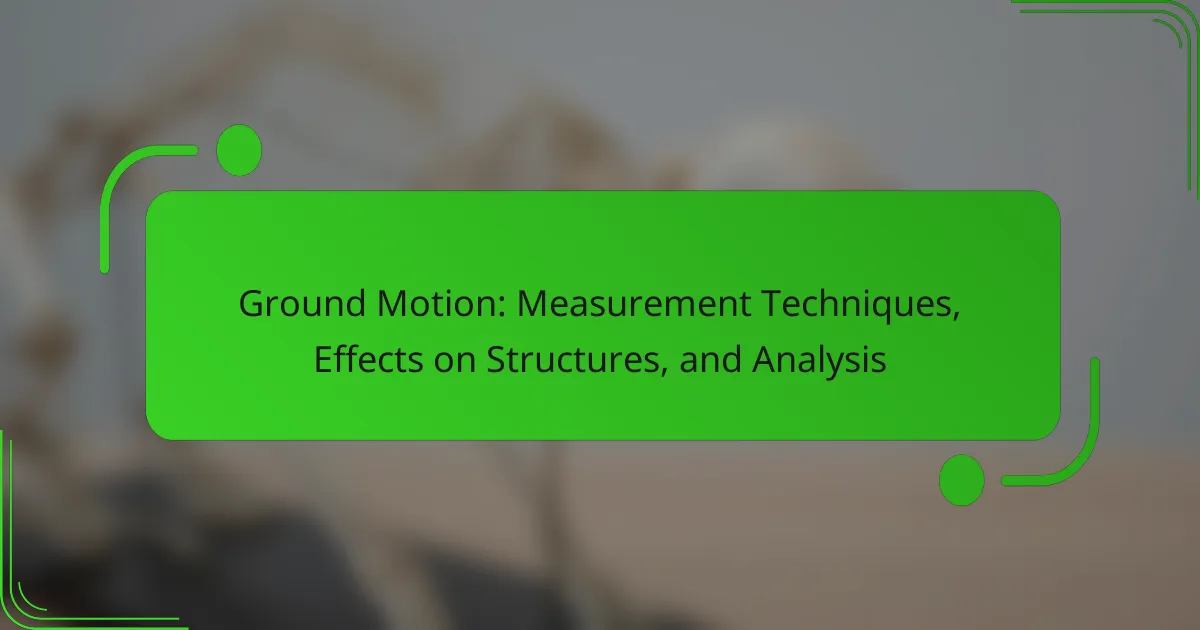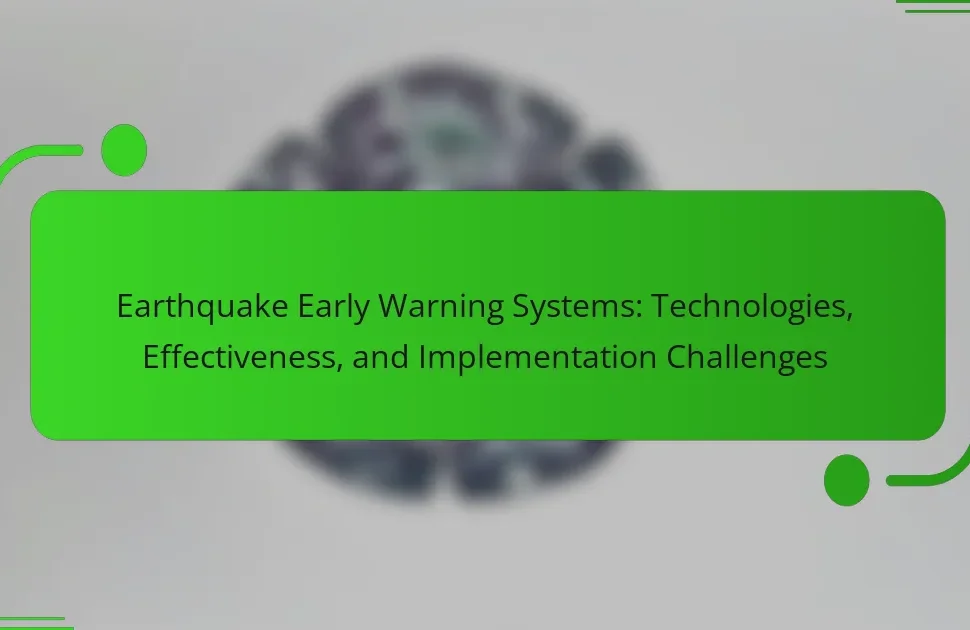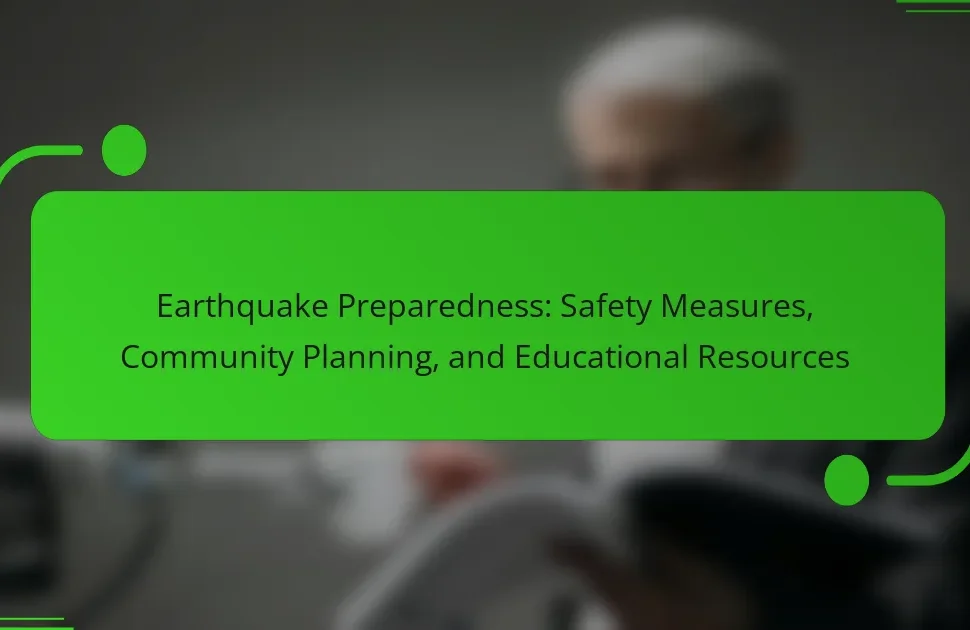Ground motion is the shaking of the ground caused by seismic waves during an earthquake, and it plays a crucial role in evaluating the impact of earthquakes on structures. The article covers various measurement techniques for ground motion, including accelerometers, displacement sensors, and GPS-based systems, each with unique applications in earthquake engineering. It highlights how ground motion induces vibrations that can lead to structural damage or failure, emphasizing the importance of designing buildings with flexible materials to mitigate these effects. Additionally, the article discusses the influence of distance from the earthquake’s epicenter and geological conditions on ground motion intensity and frequency, underscoring the significance of understanding these factors for effective structural engineering and safety assessments.
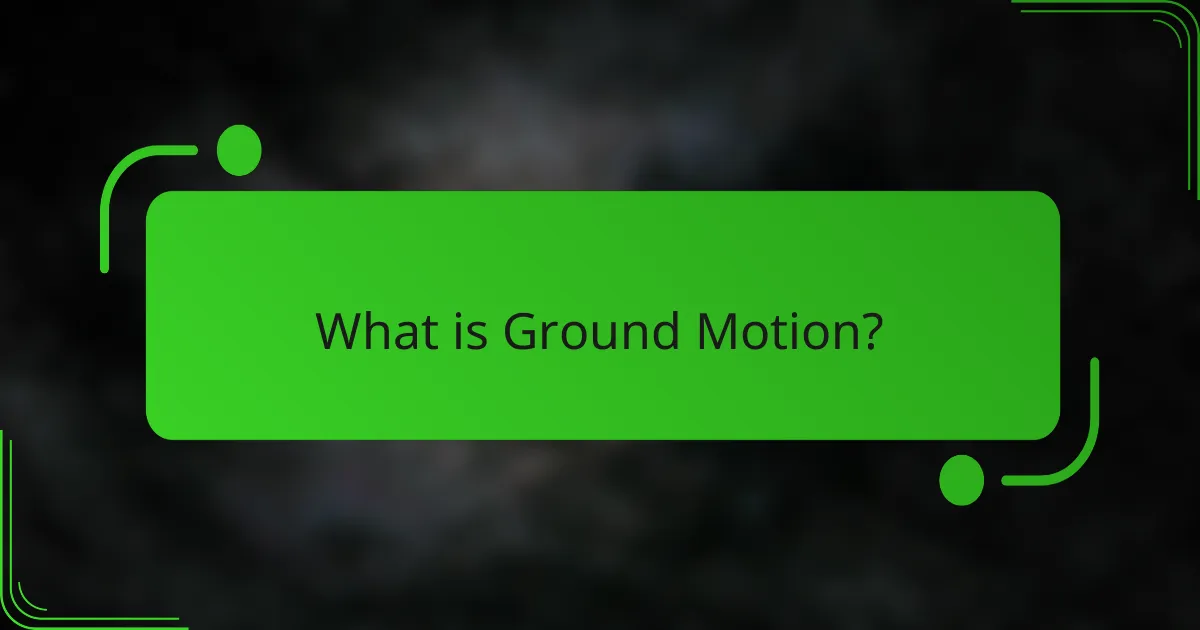
What is Ground Motion?
Ground motion refers to the shaking of the ground caused by seismic waves during an earthquake. It is a critical factor in assessing the impact of earthquakes on structures. Ground motion is measured using instruments called accelerometers. These devices capture the acceleration of ground movement in real-time. The data collected helps engineers design buildings to withstand seismic forces. Studies show that ground motion varies based on distance from the earthquake’s epicenter. Additionally, geological conditions influence the intensity and frequency of ground motion. Understanding ground motion is essential for earthquake engineering and safety assessments.
How is Ground Motion defined in the context of seismic activity?
Ground motion is defined as the movement of the ground caused by seismic waves during an earthquake. This motion can be measured in terms of acceleration, velocity, and displacement. Ground motion is critical for understanding the effects of earthquakes on structures. It influences how buildings respond to seismic events. The measurement of ground motion is essential for earthquake engineering and risk assessment. Instruments like accelerometers and seismographs are commonly used to capture this data. Studies show that ground motion characteristics vary based on factors like distance from the epicenter and local geological conditions. For instance, the 2011 Tōhoku earthquake demonstrated significant ground motion effects, impacting structures across a wide area.
What are the key characteristics of Ground Motion?
Ground motion refers to the shaking of the ground caused by seismic waves during an earthquake. Key characteristics include amplitude, frequency, and duration. Amplitude indicates the maximum displacement of the ground. Frequency describes how often the ground motion oscillates in a given time period. Duration measures the time the ground shakes during an event. These characteristics impact structural response and design. For instance, higher amplitude can cause more severe damage. Frequency influences how buildings resonate during an earthquake. Duration affects the overall energy imparted to structures. Understanding these characteristics is essential for effective engineering and safety measures.
How does Ground Motion differ from other types of motion?
Ground motion specifically refers to the movement of the ground during seismic events, such as earthquakes. Unlike other types of motion, which may include linear or rotational movements of objects, ground motion is characterized by its amplitude, frequency, and duration, which are influenced by geological conditions. Ground motion can be measured using seismographs, which provide data on the intensity and impact of seismic waves. These measurements differ from other motion types, as they focus on the earth’s response to tectonic forces rather than the motion of individual objects. Additionally, ground motion can induce vibrations in structures, leading to potential damage, which is not a concern with typical motion analysis. This unique interaction between ground motion and built environments sets it apart from other motion types, highlighting its significance in engineering and safety assessments.
Why is understanding Ground Motion important for engineering and safety?
Understanding ground motion is crucial for engineering and safety because it directly impacts the design and integrity of structures. Ground motion refers to the movement of the Earth’s surface caused by seismic events. Engineers must account for these movements to ensure buildings can withstand earthquakes and other ground disturbances. Structures that are designed without considering ground motion risks can suffer severe damage or collapse during seismic events. Historical data shows that buildings designed with ground motion analysis have significantly lower failure rates. For example, the 1994 Northridge earthquake highlighted the importance of incorporating ground motion data in building codes. In summary, understanding ground motion enhances the safety and resilience of infrastructure against natural disasters.
What are the potential risks associated with Ground Motion?
Ground motion can pose several potential risks. These include structural damage to buildings and infrastructure. High levels of ground motion can lead to the failure of bridges and roads. Additionally, ground motion can trigger landslides in hilly or mountainous areas. It can also cause soil liquefaction, where saturated soil loses strength. This results in sinking buildings and infrastructure. Furthermore, ground motion can create secondary hazards, such as tsunamis in coastal areas. Historical data show that significant earthquakes have caused widespread damage due to ground motion effects. For example, the 1994 Northridge earthquake resulted in billions in damages from structural failures.
How does Ground Motion impact urban planning and development?
Ground motion significantly impacts urban planning and development by influencing building design and infrastructure resilience. Urban planners must account for seismic activity when designing structures. This includes selecting appropriate materials and engineering techniques to withstand potential earthquakes. For instance, regions with high seismic risk often implement stricter building codes. These codes are based on historical data and geological assessments of ground motion patterns. Studies show that areas with effective ground motion assessments reduce damage during seismic events. Therefore, understanding ground motion is essential for creating safe and sustainable urban environments.
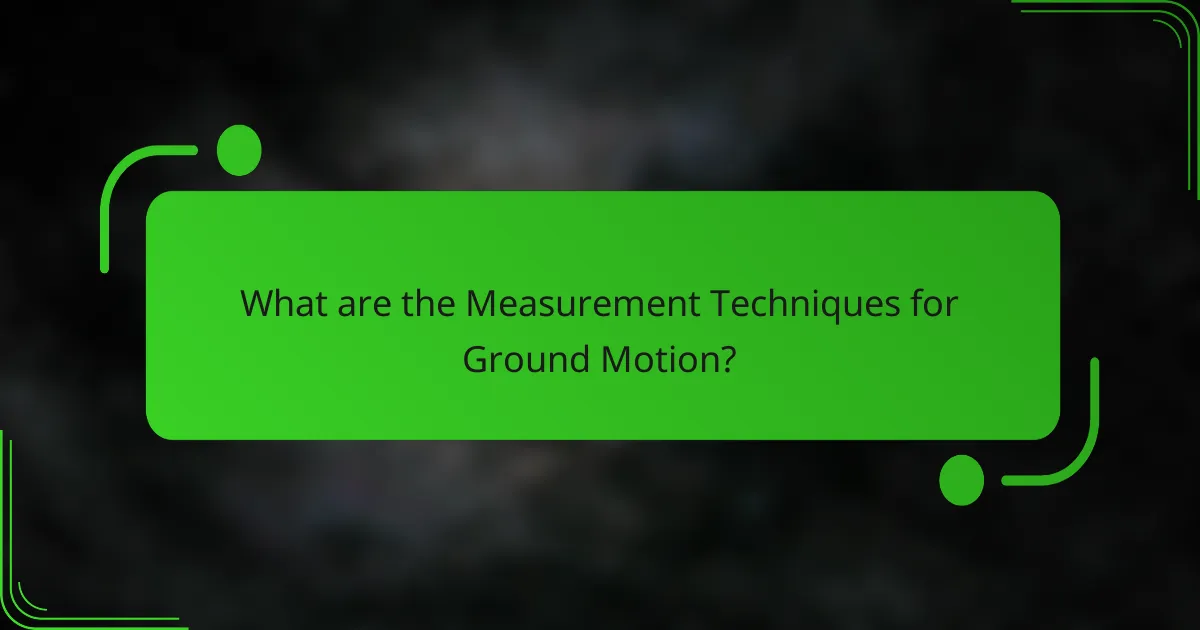
What are the Measurement Techniques for Ground Motion?
Measurement techniques for ground motion include accelerometers, displacement sensors, and GPS-based systems. Accelerometers measure the acceleration of ground motion. They provide real-time data during seismic events. Displacement sensors measure the actual movement of the ground. They are often used in structural health monitoring. GPS-based systems utilize satellite signals to track ground displacement. These systems can cover large areas with high accuracy. Each technique has specific applications in earthquake engineering. The choice of technique depends on the required precision and context of the measurement.
How are Ground Motion measurements conducted?
Ground motion measurements are conducted using instruments called accelerometers. Accelerometers detect and record the acceleration of ground movement during seismic events. They can be placed on the ground or attached to structures. Data from these devices is collected in real-time during earthquakes. The measurements are typically recorded in three orthogonal directions: vertical, north-south, and east-west. This allows for a comprehensive understanding of the ground motion characteristics. The collected data is then analyzed to assess the intensity and frequency of the seismic waves. This analysis is crucial for evaluating the impact on buildings and infrastructure.
What instruments are commonly used to measure Ground Motion?
Seismometers and accelerometers are commonly used to measure ground motion. Seismometers detect and record seismic waves from earthquakes. They provide detailed information about the amplitude and frequency of ground motion. Accelerometers measure the acceleration of ground movement. These devices are crucial for assessing the impact of seismic events on structures. Both instruments are essential in earthquake monitoring and research. They help engineers design safer buildings and infrastructure. Data from these instruments informs emergency response and preparedness efforts.
How do different measurement techniques compare in accuracy?
Different measurement techniques vary significantly in accuracy. Seismometers provide high precision in detecting ground motion. Accelerometers measure acceleration with good accuracy but may suffer from drift over time. GPS-based methods offer accurate positioning but can be affected by satellite visibility and atmospheric conditions. Each technique has a specific range of accuracy, often quantified in terms of millimeters or fractions of a second. For example, high-quality seismometers can achieve accuracy levels of up to 0.1 micrometers. In contrast, accelerometers may have an accuracy range of ±0.01g. The choice of technique depends on the specific requirements of a study, including the desired accuracy and environmental conditions.
What factors influence the choice of measurement techniques?
The choice of measurement techniques for ground motion is influenced by various factors. These factors include the type of ground motion being measured, such as seismic or non-seismic events. The precision required for the measurement also plays a crucial role. Different applications may demand varying levels of accuracy.
Environmental conditions can affect the choice of technique. For instance, urban areas may require different approaches than rural settings. The availability of technology and equipment is another significant factor. Some techniques may require specialized instruments that are not readily accessible.
Cost considerations also impact the selection of measurement methods. Budget constraints can limit the options available to researchers and engineers. Lastly, regulatory requirements may dictate specific measurement standards to be followed. These factors collectively guide the decision-making process for selecting appropriate measurement techniques.
How does the location of measurement affect data collection?
The location of measurement significantly affects data collection in ground motion studies. Different locations can yield varying seismic responses due to geological and environmental factors. For instance, measurements taken on solid bedrock differ from those on soft soil. Soft soil can amplify seismic waves, leading to higher recorded ground motions. This phenomenon is supported by studies showing that site-specific conditions influence the amplitude and frequency of seismic signals. Additionally, proximity to fault lines can result in more intense ground shaking, impacting data accuracy. Variations in elevation and local topography also contribute to discrepancies in data collection. Hence, understanding the measurement location is crucial for accurate ground motion analysis.
What role does technology play in advancing measurement techniques?
Technology plays a crucial role in advancing measurement techniques. It enhances precision and accuracy in data collection. For instance, modern sensors can detect minute ground motion changes. These sensors utilize advanced algorithms for real-time data processing. Additionally, technology allows for remote monitoring of seismic activity. This capability improves response times during earthquakes. Furthermore, data visualization tools facilitate better analysis of measurement results. This integration of technology leads to improved safety measures in structural engineering.
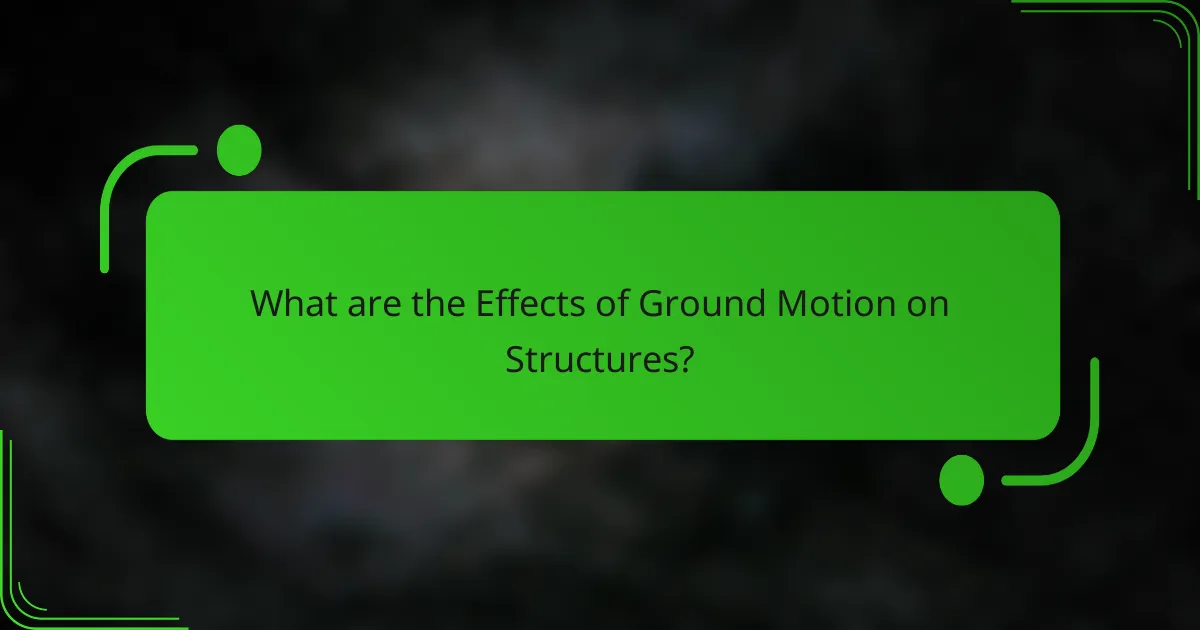
What are the Effects of Ground Motion on Structures?
Ground motion affects structures by inducing vibrations that can lead to damage or failure. These vibrations result from seismic events, such as earthquakes. Structures may experience lateral forces, vertical forces, and torsional movements during ground motion. The intensity and frequency of these motions determine the level of stress on structural components.
Buildings designed with flexible materials can absorb some ground motion effects. In contrast, rigid structures may suffer more severe damage. Research shows that poorly designed structures are at higher risk during significant seismic events. For example, the 1994 Northridge earthquake caused extensive damage to inadequately reinforced buildings.
Understanding ground motion is crucial for effective structural engineering. Engineers use seismic design principles to mitigate risks associated with ground motion. This includes incorporating damping systems and flexible foundations to enhance resilience.
How does Ground Motion affect building integrity?
Ground motion significantly affects building integrity by inducing forces that can lead to structural damage. When seismic waves travel through the ground, they generate vibrations. These vibrations can cause buildings to sway or deform. The amount of sway depends on the building’s design and materials. For instance, tall structures are more susceptible to swaying than shorter ones. Studies show that ground motion can lead to cracks in walls and foundations. In severe cases, it can cause complete structural failure. Historical earthquakes, like the 1994 Northridge earthquake, demonstrated the impact of ground motion on buildings. Structures that were not designed to withstand seismic forces suffered extensive damage. Thus, understanding ground motion is crucial for ensuring building safety and longevity.
What types of structural failures can result from Ground Motion?
Ground motion can cause various types of structural failures. Common failures include shear failure, where lateral forces exceed the structure’s capacity. This can lead to walls collapsing or buckling. Another type is flexural failure, which occurs when beams or columns bend beyond their limits. This can result in significant deformations or complete structural failure. Additionally, ground motion can cause foundation failure, where the soil loses strength, leading to settlement or tilting of the structure. These failures have been documented in numerous seismic events, highlighting the importance of designing structures to withstand ground motion.
How do different building materials respond to Ground Motion?
Different building materials respond to ground motion based on their physical properties. Concrete is rigid and can withstand significant forces but may crack under heavy stress. Steel is ductile, allowing it to absorb energy and deform without breaking. Wood is lightweight and flexible, providing resilience against vibrations but may have lower load-bearing capacity. Brick and masonry can be strong but are susceptible to shear failure during seismic events. The response of these materials is crucial in structural engineering to ensure safety and resilience. Research indicates that buildings designed with a combination of materials can enhance performance during ground motion events.
What are the long-term effects of Ground Motion on infrastructure?
Ground motion can lead to significant long-term effects on infrastructure. These effects include structural damage, increased maintenance costs, and reduced lifespan of buildings and bridges. Over time, repeated ground motion can cause fatigue in materials. This fatigue results in cracks and other forms of deterioration. For instance, the 1994 Northridge earthquake caused extensive damage to buildings, highlighting the vulnerability of infrastructure. Additionally, ground motion can compromise the integrity of foundations. This can lead to settlement issues and instability. Long-term monitoring and retrofitting are essential to mitigate these impacts. Studies show that infrastructure designed to withstand seismic activity performs better over time.
How can Ground Motion lead to cumulative damage over time?
Ground motion can lead to cumulative damage over time due to repeated stress on structures. Each seismic event imposes forces that can cause micro-damage in materials. Over time, these small damages accumulate, weakening structural integrity. For instance, studies show that buildings subjected to frequent ground motion can experience significant degradation. The National Earthquake Hazards Reduction Program notes that even minor tremors can contribute to structural fatigue. As materials lose their strength, the risk of failure increases. This cumulative effect is particularly pronounced in older buildings not designed for modern seismic standards.
What are the economic implications of Ground Motion on structures?
Ground motion significantly impacts the economic viability of structures. It can lead to substantial repair costs following seismic events. For instance, the 1994 Northridge earthquake caused approximately $44 billion in damages in California. Structures that are not designed to withstand ground motion may face increased insurance premiums. Additionally, ground motion can affect property values, as buyers may be deterred by potential risks. The cost of retrofitting existing buildings to meet seismic standards can be considerable. Economic implications also extend to construction delays and loss of productivity during repairs. Overall, the financial burden of ground motion on structures can be profound and far-reaching.
How can we analyze and mitigate the effects of Ground Motion?
To analyze and mitigate the effects of ground motion, engineers utilize seismic monitoring and structural design techniques. Seismic monitoring involves using accelerometers and seismographs to measure ground motion. These instruments provide real-time data on the intensity and duration of seismic events. Structural design techniques include retrofitting buildings with base isolators and dampers. Base isolators allow structures to move independently of ground motion. Dampers absorb energy from seismic waves, reducing structural stress.
Research shows that buildings designed with these techniques can withstand significant ground motion. For example, the Tokyo Skytree incorporates advanced seismic design features. It has a tuned mass damper that minimizes swaying during earthquakes. Studies indicate that such designs can reduce damage by over 50%.
In summary, analyzing ground motion through monitoring and mitigating its effects via advanced structural techniques is essential for enhancing safety and resilience.
What strategies are effective in minimizing Ground Motion impacts?
Effective strategies for minimizing ground motion impacts include engineering solutions, site selection, and real-time monitoring. Engineering solutions involve designing structures to withstand seismic activity. This can include using flexible materials and reinforcement techniques. Site selection focuses on avoiding construction on unstable soils or near fault lines. Real-time monitoring utilizes sensors to detect ground motion and provide immediate data for response. These strategies collectively enhance a structure’s resilience to seismic events. Studies show that buildings designed with these strategies sustain less damage during earthquakes. For example, the 2011 earthquake in Japan highlighted the importance of such engineering practices.
How does ongoing analysis contribute to safer building practices?
Ongoing analysis contributes to safer building practices by enabling continuous monitoring and assessment of structural integrity. This process helps identify potential weaknesses in buildings before they become critical issues. Regular analysis of ground motion data allows engineers to understand how structures respond to seismic activity. It also aids in updating safety standards based on real-time data and historical performance. For instance, the United States Geological Survey (USGS) provides data on ground motion that informs building codes. This data-driven approach has led to improved designs that withstand earthquakes better. Ultimately, ongoing analysis ensures that buildings are constructed and maintained with the latest safety insights.
What best practices should be followed in Ground Motion analysis?
Best practices in Ground Motion analysis include selecting appropriate ground motion records. These records should be representative of the site conditions and seismic hazard. Additionally, it is essential to apply consistent processing techniques to all records. This ensures comparability and reliability of the results.
Using a sufficient number of records is also critical. A minimum of 10 to 20 records is often recommended to achieve statistical significance. Furthermore, it is important to consider the scaling of ground motions. Scaling should be done to match the target spectrum of the site.
Incorporating site-specific response spectra enhances the accuracy of the analysis. This approach accounts for local geological conditions. Lastly, documenting all methodologies and assumptions is vital for transparency. This allows for reproducibility and peer review of the analysis.
Ground motion is the shaking of the ground caused by seismic waves during earthquakes, crucial for assessing structural impacts. This article covers the definition of ground motion, its measurement techniques using accelerometers and seismographs, and the effects on building integrity and infrastructure. Key characteristics such as amplitude, frequency, and duration are discussed, along with the risks associated with ground motion, including structural failures and cumulative damage over time. The article emphasizes the importance of understanding ground motion for effective engineering practices and urban planning to enhance safety and resilience against seismic events.
